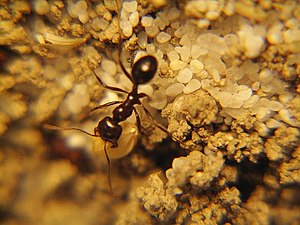Messor
| Messor | ||||||||||||
|---|---|---|---|---|---|---|---|---|---|---|---|---|

Messor barbarus's worker with a millet grain |
||||||||||||
| Systematics | ||||||||||||
|
||||||||||||
| Scientific name | ||||||||||||
| Messor | ||||||||||||
| Forel , 1890 |
Messor is a genus of ants (Formicidae) that belongs to the subfamily of knot ants (Myrmicinae). All species of this genus feed mainly on plant seeds and are therefore among the harvest ants . Its Latin (scientific) name is derived from Messor (reaper, from messis = the mowing), one of the 12 harvest workers of the Roman goddess of agriculture, Ceres .
features
In the case of Messor species, there are extreme differences in size between the workers. The smallest specimens measure four millimeters, whereas some reach up to 10 to 14 millimeters (depending on the species) and develop strikingly large heads. There are also countless intermediate forms, so this is not a real polymorphism. The tall workers are responsible for cracking the grains. The color of most species is dark brown to black, although there are exceptions, such as B. Messor barbarus , who can have a distinctly red head. The sting has regressed and fights are fought with the mouthparts. Colony foundations are usually established claustrally by a single queen or in pleometrosis . The colonies are monogynous in most species and the sex animals usually swarm in midsummer. Some species overwinter with sex animals, so that a second swarm occurs in spring, or the swarm only takes place in spring.
distribution and habitat
Representatives of the genus Messor are mainly native to the steppes and semi-deserts of the Palearctic . They prefer warm and dry places. They are found frequently in the Mediterranean area , but very rarely in Central Europe and only found in warmer locations. So Messor structor the only proven in Germany Art. It is only in the Rhine region of Koblenz to the area to Mainz and Wiesbaden and at the Kaiserstuhl to find.
Way of life
These ants are the most well-known harvest ants in the northern hemisphere. Since most of their nutritional needs are met by plant seeds, they have an important impact on the ecosystem . The large quantities of collected grains are sorted according to plant species in the extensive underground nests and the pods are removed. The shells are piled up outside the nest. The seeds are processed by workers by chewing them for hours and enriching them with enzymes. This creates the so-called "ant bread", which is the basic food for these ants and their brood. All species also feed on zoophagus and weakly phytophagous , especially when there are few seeds available due to the season.
Systematics
The genus Messor is represented in Europe with around 40 species and subspecies. Over 100 species are known worldwide .
Some important representatives in Central Europe are the following types (selection):
Synonyms
Synonyms for the genus Messor :
- Cratomyrmex Emery, 1892
- Lobognathus Enzmann, 1947
- Veromessor Forel, 1917
swell
Individual evidence
- ↑ a b c Bernhard Seifert : The ants of Central and Northern Europe . lutra Verlags- und Vertriebsgesellschaft, Görlitz / Tauer 2007, ISBN 978-3-936412-03-1
- ↑ Heiko Bellmann : bees, wasps, ants. Hymenoptera of Central Europe . Franckh-Kosmos, Stuttgart 1995, ISBN 3-440-09690-4
- ↑ Messor Forel 1890. Fauna Europaea, accessed May 17, 2008 .
- ↑ Hölldobler and Wilson : The Ants . Springer (1990) ISBN 3-540-52092-9
